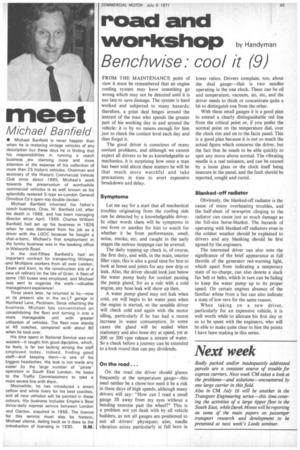road and workshop
Page 65

If you've noticed an error in this article please click here to report it so we can fix it.
Bench wise: cool it (9)
by Handyman
FROM THE MAINTENANCE point of view it must be remembered that an engine cooling system may have something go wrong which may not be detected until it is too late to save damage. The system is hard worked and subjected to many hazards; therefore, a great deal hinges around the interest of the man who spends the greater part of his working day in and around the vehicle: it is by no means enough for him just to check the coolant level each day and then forget it.
The good driver is conscious of many coolant problems, and although we cannot expect all drivers to be as knowledgeable as mechanics, it is surprising how once a man has been told about these matters he will be that much more watchful and take precautions in time to avert expensive breakdown and delay.
Symptoms
Let me say for a start that all mechanical troubles originating from the cooling side can be detected by a knowledgeable driver. In other words there will be symptoms in one form or another for him to watch for whether it be from performance, smell. noise, smoke, etc. and caught in the early stages the serious stoppage can be averted.
The daily topping-up check is, of course. the first duty, and with, in the main, interior filler caps. this is also a good time for him to look at hoses and joints for any new drip or leak. Also, the driver should look just below the water pump body for coolant passing the pump gland, for as a rule with a cold engine, any hose leak will show up then.
A water pump gland may not leak when cold, yet will begin to let water pass when the engine is started, so the sensible driver will check cold and again with the motor idling, particularly if he has had a recent increase in water consumption. In some cases the gland will be sealed when stationary and also bone dry at speed, yet at 200 or 300 rpm release a stream of water. So a check before a journey can be extended to a look round that can pay dividends.
On the road ...
On the road the driver should glance frequently at the temperature gauge—this need neither be a chore'nor need it be a risk in these days of high speeds, although many drivers will say: "How can I read a small gauge 311 away from my eyes without a bending exercise past the wheel?" This is a problem not yet dealt with by all vehicle builders, as not all gauges are positioned to suit all drivers' physiques; also, needle vibration exists particularly at full bore in lower ratios. Drivers complain, too, about the dual gauge—that is two needles operating in the one clock. These can be oil and temperature. vacuum, air, etc, and the driver needs to think or concentrate quite a bit to distinguish one from the other.
With these small gauges it is a good plan to extend a clearly distinguishable red line from the critical point or, if you prefer the normal point on the temperature dial, over the clock rim and on to the facia panel. This is a good plan because it is not so much the actual figure which concerns the driver, but the fact that he needs to be able quickly to spot any move above normal. The vibrating needle is a real nuisance, and can be caused by a loose glass or the clock itself being insecure in the panel, and the fault should be reported, sought and cured.
Blanked-off radiator
Obviously, the blanked-off radiator is the cause of many overheating troubles, and the half-sheet of newsprint clinging to the radiator can cause just as much damage as the full-size horse-blanket. The hazards of operating with blanked-off radiators even in the coldest weather should be explained to drivers and any blanking should be first agreed by the engineers.
The interested driver can also note the significance of the brief appearance at full throttle of the generator red-warning light, which apart from indicating a temporary state of no-charge. can also denote a slack fan belt or belts, which in turn can be failing to keep the water pump up to its proper speed. On certain engines absence of the familiar whine from a fan can also indicate a state of low revs for the same reason.
When taking on a new driver, particularly for an expensive vehicle, it is well worth while to allocate his first day or so to be spent with the engineers, who will be able to make quite clear to him the points I have been making in this series.












































































































































